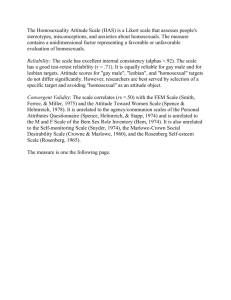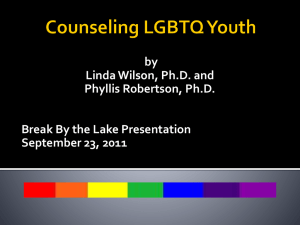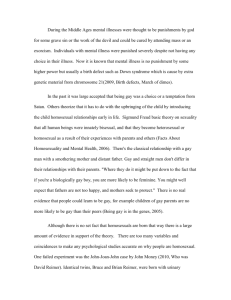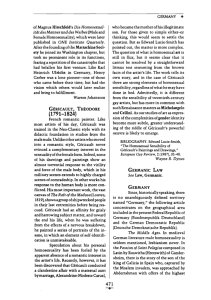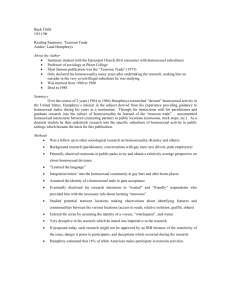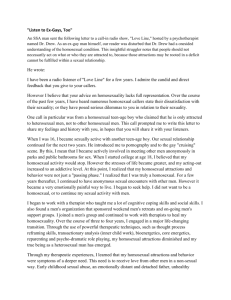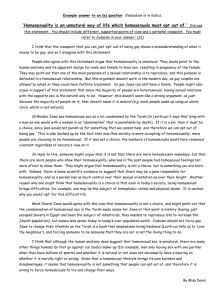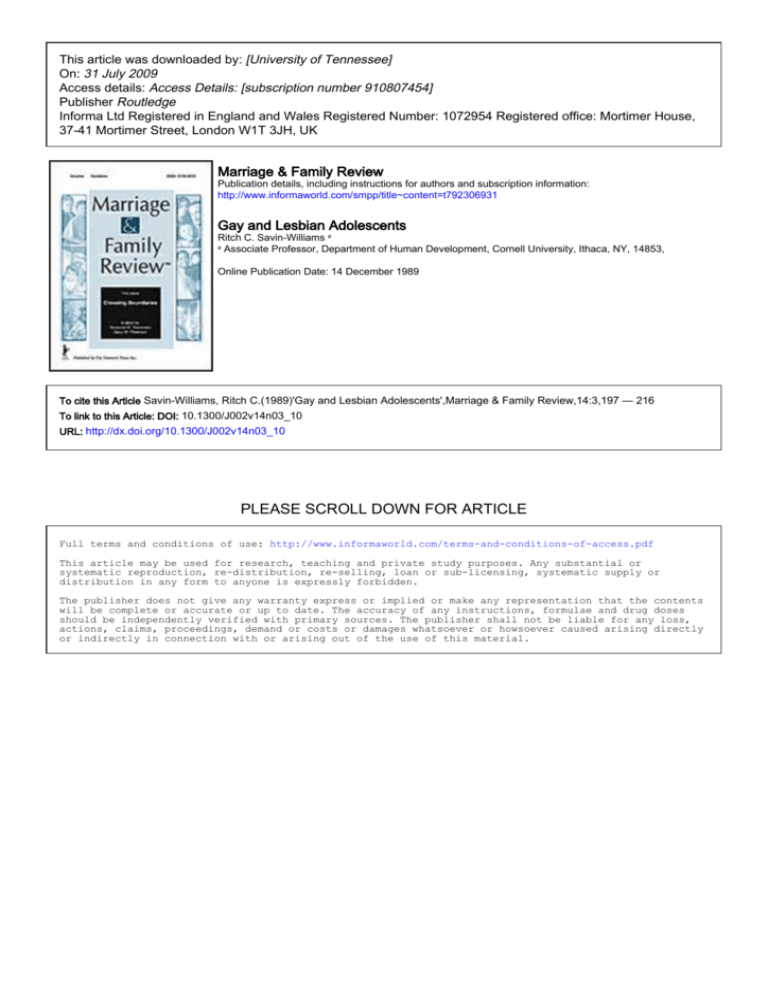
This article was downloaded by: [University of Tennessee]
On: 31 July 2009
Access details: Access Details: [subscription number 910807454]
Publisher Routledge
Informa Ltd Registered in England and Wales Registered Number: 1072954 Registered office: Mortimer House,
37-41 Mortimer Street, London W1T 3JH, UK
Marriage & Family Review
Publication details, including instructions for authors and subscription information:
http://www.informaworld.com/smpp/title~content=t792306931
Gay and Lesbian Adolescents
Ritch C. Savin-Williams a
a
Associate Professor, Department of Human Development, Cornell University, Ithaca, NY, 14853,
Online Publication Date: 14 December 1989
To cite this Article Savin-Williams, Ritch C.(1989)'Gay and Lesbian Adolescents',Marriage & Family Review,14:3,197 — 216
To link to this Article: DOI: 10.1300/J002v14n03_10
URL: http://dx.doi.org/10.1300/J002v14n03_10
PLEASE SCROLL DOWN FOR ARTICLE
Full terms and conditions of use: http://www.informaworld.com/terms-and-conditions-of-access.pdf
This article may be used for research, teaching and private study purposes. Any substantial or
systematic reproduction, re-distribution, re-selling, loan or sub-licensing, systematic supply or
distribution in any form to anyone is expressly forbidden.
The publisher does not give any warranty express or implied or make any representation that the contents
will be complete or accurate or up to date. The accuracy of any instructions, formulae and drug doses
should be independently verified with primary sources. The publisher shall not be liable for any loss,
actions, claims, proceedings, demand or costs or damages whatsoever or howsoever caused arising directly
or indirectly in connection with or arising out of the use of this material.
Gay and Lesbian Adolescents
Ritch C. Savin-Williams
Downloaded By: [University of Tennessee] At: 21:36 31 July 2009
OVERVIEW
Adolescents who declare their homosexuality have recently become a highly controversial, and yet, "invisible" minority in Western societies. This cultural phenomenon has emerged because increasing numbers of youth want to explore and express sexual
behaviors and identities beyond the heterosexual ones that are traditionally assumed by most parents. Adolescents with a homosexual
sexual orientation and who engage in homosexual behavior have
always existed; how, a gay~lesbianidentity is evolving.
Distinguishing among sexual orientation, behavior, and identity
is a primary goal of this paper. Another is to reduce the invisibility
of lesbian and gay adolescents- to social scientists, health care providers, the lesbian and gay communities, gaynesbian youths and
their parents. Finally, a third goal is to alert parents and health care
providers to some of the issues, such as irrational fears, peer ridicule, lack of support, and misunderstandings, that are directly responsible for the poor physical and psychological health of some
lesbian and gay youth.
In general, the above groups have been hesitant to challenge the
stigmatic, legal, and moral issues involved with gay and lesbian
minors. Perhaps they fear the label of "guilty by association" as
well as the unique dread of stereotypes that are usually applied to
Ritch C. Savin-Williams. PhD. is Associate Professor in the Deoartment of
Human Development and ~ a m istudies,
l~
Cornell University. ~orr'es~ondence
may be sent to the author at the Department of Human Development, MVR Hall.
Cornell University, Ithaca, NY 14853.
This article is based on material contained in Chapter 9 of Invisible and Forgotfen: A Study of Gay and Lesbian Youths (Savin-Williams, in press).
O 1990 by The Haworth Press, Inc. All rights reserved.
197
Downloaded By: [University of Tennessee] At: 21:36 31 July 2009
198
HOMOSEXUALITY AND FAMILY RELATIONS
those who associate with gay and lesbian youth (e.g., pedophile).
Theo Sandfort noted during a recent speaking tour of the United
States that these negative reactions are usually more severe here
than in other, more sex-positive societies such as his Netherlands.
Even those most concerned with issues of homosexuality appear to
assume that this sexual orientation is a prerogative only of adulthood.
But gay and lesbian youth are also frequently invisible to thernselves. This is an inherent problem for minorities in American society, especially if their minority status is based on perceived "deviancy" from societal norms. This failure to come forth compounds
the difficulty of finding gay and lesbian youth as research participants, thus amplifying their invisibility. As a result, social scientists
either ignore gay and lesbian youth in their research or they rely on
retrospective data gathering techniques that ask gay and lesbian
adults to reflect on their adolescence to recall important events,
feelings, and thoughts. Yet, recall data methodologies make particular and often debatable, assumptions concerning the accuracy of
adult memories of childhood sexual feelings and behaviors (Boxer
& Cohler, 1988; Ross, 1980).
Until recently an unspoken assumption in traditional research on
homosexuality has been that all lesbians and gays are essentially
very much alike. Fortunately, however, several researchers have
addressed the heterogeneity within the gay and lesbian population.
For example, Alan Bell and Martin Weinberg's 1978 book, Homoserualities, noted that variables such as age, educational level, and
religious feelings influence the attitudes, behaviors, and beliefs of
gays and lesbians. Their emphasis on "within group variations"
resulted in a presentation of various portraits of gay and lesbian
adults. Although they exploded the myth, few social scientists,
health care providers, or the mass media have listened. As a result,
cognizance of the diversity within the lesbian and gay population
has been pre-empted by a focus - perhaps an obsession -on characteristics thought to distinguish homosexual from heterosexual people.
One source of variation is age. Gay and lesbian youth may be
quite different from adults, both gay and straight, but in many important ways similar to other adolescents. For example, it is highly
Downloaded By: [University of Tennessee] At: 21:36 31 July 2009
Ritch C. Savin- Williams
199
likely that gay and lesbian youth, similar to other youth, internalize
and incorporate to some degree into their self-image their perceptions of others, such as family members. Thus, if parents reject
their son or daughter because of his or her sexual orientation, then
the adolescent may too reject himself or herself and develop low
self-esteem or become suicidal. If indeed it proves to be the case
that sexual orientation per se produces minimal differences in developmental processes,-then focusing on the frequently belaboured
and believed differences that have been the orimarv mainstav of
social scientists who seem bent, whenever po'ssible,'on emphisizing gay versus straight comparisons has been a waste of time.
Thus, far more intra-gayflesbian population studies that explore
unique and diverse patterns within a homosexual sexual orientation
are needed. One promising characteristic has been suggested by
several researchers (Green, 1987; Harry, 1983; Hart et al., 1978)cross-gender personality and social role orientation. With this effort
social scientists increase the likelihood of learning about normal
development in all of its manifestations.
SEXUAL ORIENTATION, SEXUAL BEIUVXOR,
AND SEXUAL IDENTITY
Self-Labe1
An initial difficulty is defining the gay or lesbian adolescent to
the self and to others, especially to the family. This is not an easy
task during this age period for two reasons. First, to many families
gay and lesbian youth do not and cannot exist. Instead, if families
discover or are told of "peculiar behaviors or inclinations" the accused adolescents are viewed as homosexually behaving youths
temporarily detained from their destination as heterosexual adults.
Youth themselves frequently buy into this safety net.
Second, adolescents are more likely to experience cross-orientation sexual contact than are adults, but are less likely to define
themselves as homosexual individuals. Only one of 1,067 youths in
a recent representative sample of adolescents (Coles & Stokes,
1985) checked the "homosexual" identity box. Yet, 5% reported
that they had engaged in homosexual behavior during adolescence.
Downloaded By: [University of Tennessee] At: 21:36 31 July 2009
200
HOMOSEXUALIWAND FAMILY RELATIONS
In a 1985 survey of 356, 16- to 18-year-old high school students
enrolled in Cornell University's Summer College, only three labeled themselves as bisexual/homosexual; five rated themselves as
"more than incidentally homosexual" and 15 as "incidentally homosexual" on the Kinsey scale (Savin-Williams, in preparation).
The next year, of 176 youths surveyed during the same program
only one student expressed same-sex sexual attraction; another four
replied "both sexes equally." Behaviorally, 12 reported past and
eight current "casual" homosexual encounters; three reported genital-genital homosexual contact in their past (Savin-Williams, unpublished data). Thus, youth are far more likely to "admit" to homosexual acts than to a homosexual idcntity.
It is unclear from the empirical research whether cohort or developmental effects have the greatest determination for self-label as
lesbianlgay. Andrew Boxer and Bert Cohler (1989) make the strong
argument that because of past research efforts, primarily cross-sectional studies of the remembered past of gay and lesbian adults,
little is known concerning either developmental processes or cultural/historical effects on gay and lesbian adolescents. The argument here is for a developmental paradigm, without the intention of
negating or ignoring cohort effects. Indeed, it is probably easier to
come out as homosexual today as a youth than it was during previous generations who came into their adolescence before the
bench-mark 1969 Stonewall encounter with the New York City police. If it were possible to control or account for historical time, I
believe developmental differences in coming out would still emerge.
With advancing age, especially after the increase in sexual libido
and cognitive abilities during pubescence, the equation of sexual
behavior and sexual identity becomes both easier and more necessary.
Definitions
An important differentiation is distinguishing among sexual orientation, sexual behavior, and sexual identity. A homosexual sexual orientation is thought to consist of a preponderance of sexual
feelings, erotic thoughts or fantasies, and/or behaviors desired with
respect to members of the same sex. It is present from an early
Downloaded By: [University of Tennessee] At: 21:36 31 July 2009
Ritch C. Savin- Williams
201
age-perhaps at conception (see Savin-Williams, 1987a). Homosexual activity or the "homosexually stimulating experience"
(Rigg, 1982) connotes sexual behavior between members of the
same sex. Sexual identity, by contrast, represents a consistent, enduring self-recognition of the meanings that the sexual orientation
and sexual behavior have for oneself. Although a public declaration
of this status is not inherently necessary for sexual identity, there
must be some level of personal recognition of this status. Affirmation, to varying degrees, may or may not follow. These definitions
serve to illustrate the essential differences among sexual orientation, sexual behavior, and inner identity. Although it is likely that
the three will be somewhat or highly correlated, this may be more
of a future, adult than a present, adolescent reality. This issue is
particularly crucial in reference to teenaged populations because it
appears that many forms of sexual activity with partners varying in
age, sex, and other person variables are commonplace-regardless
of self-labeled or self-professed sexual orientation and identity.
The confusion is illustrated by two seemingly opposite facts:
Some gay and lesbian adolescents are homosexual virgins and some
heterosexual adolescents engage in extensive and prolonged homosexual behavior. Studies (Boxer, 1988; Remafedi, 1987a; Roesler
& Deisher, 1972; Sanders, 1980; Savin-Williams, in press) of gay
male and lesbian youths support the claim that some accept the selflabel of gayllesbian before they have had homosexual experiences.
For example, in one study (Savin-Williams, in press) 5% of the
males and 12% of the females were homosexual virgins. Yet, they
responded on the questionnaire that their orientation was bisexual/
homosexual. Among 118 youths who came to Chicago's Horizons
Center, 9% of the boys and 6% of the girls had never experienced
same-sex activity (Boxer, 1988). Martin Manosevitz (1970) reported that 22% of his male sample was homosexual virgins during
the ages of 13-17years and 4% during the ages 18-24years. In Jack
Hedblom's study (1973) 66% of the female sample was homosexual
virgins before age 15 years and 21% at age 20 years. Barry Dank
(1971) concluded: "It is theoretically possible for someone to view
himself as being homosexual but not engage in homosexual relations just as it is possible for someone to view himself as heterosexual but not engage in heterosexual relations (p. 117)."
202
HOMOSEXUALITYAND FAMILY RELATIONS
On the other hand, clearly not all adolescents who engage in
homosexual behavior would identify themselves as gay or lesbian.
Alfred Kinsey, Wardell Pomeroy, and Clyde Martin (1948, pp. 629
& 651) found:
Downloaded By: [University of Tennessee] At: 21:36 31 July 2009
Between adolescence and 15 years of age about 1 male in 4
(27%) has some homosexual experience. The figures rise to 1
male in 3 in the later teens and appear to drop a bit in the early
twenties.
Yet,
4 percent of the white males are exclusively homosexual
throughout their lives, after the onset of adolescence.
Richard Pillard (1974) noted that 35% of males in his research under 19 years of age had experienced a "homosexual encounter." In
the Sorensen Report (1973), 5% of the boys and 6% of the girls
between the ages of 13 to 15 years responded positively to the statement, "Have you had activity with another boy [girl] or with a
grown man [woman] that resulted in sexual stimulation or satisfaction for either or both of you?" (p. 432). Among 16- to 19-year olds
the percentage of boys marking "yes" more than tripled to 17%
while the proportion of girls remained at 6%. Marcel Saghir and Eli
Robins (1973) reported 23% of their heterosexual males had homosexual contacts by age 15 years; C. V. Ramsey (1943), 31% by age
17 years; and Martin Manosevitz (1970), 23% by age 17 years.
Among females the percentages are smaller but in the same direction. In Kinsey's study (1953), by age 15 years 5% of the females
had experienced homosexual contact and 2% were exclusively homosexual by sexual orientation. Ten percent of 160 women in a
university dormitory had homosexual encounters (Coode & Haber,
1977). Others (Manosevitz, 1970; Ramsey, 1943; Saghir & Robins,
1973; Sorensen, 1973) reported similar statistics and conclusions.
Alan Malyon (1981) speculated that about nine in ten reports by
youth of same-sex erotic interest are made by those predominantly
heterosexual in orientation. However, Gary Ross-Reynolds (1982,
p. 70) concluded: "The majority of adolescents who engage in homosexual behavior do not continue this practice into adulthood.
Downloaded By: [University of Tennessee] At: 21:36 31 July 2009
Ritch C. Savin- Williams
203
Conversely, as many as 31% of gay adults engaged in no homosexual behavior until they were out of high school." This quote illustrates the difficulty of equating homosexual behavior with either
sexual orientation or identity.
On the other hand, there is ample evidence that "pre-"gaynesbian adolescents are more likely than others to engage in homosexual behavior and to do so for a longer period of time. For example,
Alan Bell, Martin Weinberg, and Sue Hammersmith (1981a & b)
reported that 95% and 70% of their homosexual men and women,
respectively, but only 20% and 6% of their heterosexual men and
women had been sexually aroused by a member of the same sex
before they reached 19 years of age. Only 2% and 0% of the latter
rated their pre-adult sexual behaviors as predominantly homosexual, as opposed to 56% and 44% of the homosexual men and
women who so reported. In another sample of gay men and women
(Saghir & Robins, 1969; Saghir, Robins, & Walbran, 1969), 87%
had homosexual contacts before the age of 19 years. In a West
German sample of women, 52% had homosexual contacts by the
same age (Schafer, 1977). Compared to heterosexuals, Martin
Manosevitz (1970) noted:
The homosexuals appeared to have been more active in total
frequency of sexual behavior earlier, but this difference disappears by adolescence. They seemed to start earlier, and the
direction of their activities was towards same-sexed partners
. . . Then many shifted to male and female partners during
adolescence and early adulthood. (p. 401)
During childhood (5-9 years) 41% of the homosexual males had
same-sex sexual activity and this proportion steadily increased to
59% during preadolescence (10-12 years), 70% during adolescence
(13-17 years), and 96% during late adolescence and youth (18-24
years). The percentages of heterosexuals engaging in homosexual
behavior were considerably lower and decreased rather than increased after preadolescence: 5% (childhood), 25% (preadolescence), 15% (adolescence), and 5% (late adolescence) (Manosevitz,
1970). In a study of gay male youths between the ages of 16 and 22
years, Thomas Roesler and Robert Deisher (1972) reported that the
Downloaded By: [University of Tennessee] At: 21:36 31 July 2009
204
HOMOSEXUALI7YAND FAMILY RELATIONS
majority described early, prepubertal homosexual activity (e.g.,
mutual body exploration or curiosity based sex play). Of 29 homosexual or bisexual male youths, 15 to 19 years of age, 28 had past
homosexual encounters, but most of these occurred during earny
adolescence (Remafedi, 1987a). Paul Van Wyk and Chrisann Geist
(1984) documented among Kinsey's sample that the more elevated
the homosexual score the greater the likelihood of prepubertal sexual contact with boys or men for homosexual men.
Andrew Boxer (1988) noted two pathways of "initiation into
sexual identity formation" among the Chicago gay male youths.
The mean age of first same-sex activity for 75% of the males was
15.0 years; all began homosexual activity after the age of 11 years.
The other cluster of males (25%) reported that their first same-sex
activity, usually with a same-aged peer, occurred prior to age 9
years (mean = 6.5 years). Thus, research that treats all gay and
lesbian youth as if they were engaged in identical developmental
pathways may be obscuring important developmental processes and
outcomes. This theme is pursued in much greater depth in a recent
book on gay and lesbian youth (Savin-Williams, in press).
There can thus be little doubt that not only does homosexual behavior occur during adolescence, it may aiso be quite prevalent.
Such behavior, however, may or may not be indicative of a homosexual orientation or identification. Given the complexity of
whether one defines homosexuality by reference to orientation, behavior, or self-label and the fact that many teens experience a diversity of sexual behaviors and an emerging sexual identity over a
period of several years, a process that may not be completed until
young adulthood, it is difficult to assess the prevalence of a homosexual orientation among adolescents. Despite this handicap, it is
abundantly clear that gay and lesbian youth exist during childhood
and adolescence-with or without homosexual behavior andlor a
homosexual identity.
Cross-Cultural Research
Although homosexuality is probably universal cross-culturally, it
is clearly not documented in all cultures. This is perhaps due to the
secretive nature in which it is carried out and the difficulty of satis-
Downloaded By: [University of Tennessee] At: 21:36 31 July 2009
Ritch C. Savin- William
205
factorily applying a common definition to or empirically assessing
the abstract construct of homosexuality as a sexual orientation. Because homosexual behavior is more clearly demarcated and observable, it is more frequently documented cross-culturally (Ford &
Beach, 1951).
In various human cultures adolescent homosexual behavior may
be viewed as a necessary outlet (because the sexes are separated), as
preparatory for heterosexual activity (to learn about sex), as giving
ritualized status such as manhood (a semen implant for masculinity
to thrive), as playful acting out of the increased sexual libido derived from pubertal hormones, or (rarely) as an expression of a lifelong sexual orientation. Homosexuality is seldom accepted crossculturally after adolescence as a natural, life-long expression of
sexuality (Ford & Beach, 1951). One extreme view is that of Warren Gadpaille (1980), who concluded that homosexuality as a preferred sexual expression is universally deeined deviant, although he
noted that in some cultures homosexuality has been given an institutional role and its stigmatization has been moderated. Clearly, societies vary in how they react to the emergence of homosexual behavior among their adult citizens, including the degree to which they
allow it to be overtly manifested and stigmatized. On the other
hand, some cultures celebrate, perhaps even proscribing, homosexual behavior among their adolescents (e.g., Sambia in New Guinea
[Herdt, 19811). Two-thirds of modern tribes in South America consider adolescent homosexuality to be both normal and acceptable
(noted in Tannahill, 1980). Other cultures toleratelignore homosexual behavior or, if brought out into public view, actively discourage
it.
A classic example of the latter is the English public school system. In the late 19th century it kept boys secluded from girls in a
monastic fashion through most of childhood and adolescence (Tannahill, 1980). With the Oscar Wilde "scandal" many well-bred
Englishmen came to recognize that not only were Eton, Harrow,
and Winchester "breeding grounds" for homosexual behavior but
that some adolescent boys continued the behavior into adulthood.
Lax laws against sodomy were then enforced with moral conviction.
Despite the fact that striking changes have occurred in the United
Downloaded By: [University of Tennessee] At: 21:36 31 July 2009
206
HOMOSEXUALIWAND FAMILY RELATIONS
States over the past decade in terms of the visibility of lesbians and
gays, it is instructive to note that many past, antihomosexual theories
and treatment approaches remain as part of the belief system of a
considerable number of professionals. A review by Sandra Schwanberg (1985) noted that this is most pronounced in psychiatry and
less so in psychology, medicine, nursing, and the social sciences.
Almost exclusively, however, conceptualizations of homosexuality
have focused on adult sexual behavior, with only occasional reference to adolescents. Nonetheless, these general theories necessarily
influence the education and training of health care personnel, and
consequently the forms of health care and intervention strategies
used in contacts with gay and non-gay adolescents.
Cultural shifts are evident, however, in the United States. For
example, although the medical journal Pediatrics in 1969 recognized the importance of adolescent homosexuality for scientific and
humanistic reasons, it was considered to be a "developmental deviance" (Solnit, 1969). Fourteen years later, in 1983, the position of
the American Academy of Pediatrics, Committee on Adolescence,
was quite different: Homosexuality as a sexual orientation is established before adolescence; homosexual behavior is common "en
route to conventional heterosexual development" (p. 249); homosexual behavior may occur given particular environmental contexts
(incarceration, single sex boarding schools, military barracks);
problems with homosexuality are usually the consequence of social
conditions rather than of mental illness; and the necessity for a positive attitude on the part of the pediatrician was emphasized.
Explanations for Adolescent Homosexual Behavior
Great effort, primarily anecdotal in nature, has been made to explain the relatively high frequency of homosexual experiences
among teenagers. Some (Glasser, 1977; Rigg, 1982) argued that
sexual experimentation involving exploration of bodies and reactions with same-sexed peers occurs because such activities are more
familiar and therefore less threatening than similar heterosexual
physical contact; reassurance is gained from mutual comparisons of
size, shape, and sensations associated with changing bodies and sex
organs (Sorensen, 1973). Others (e.g., Chng, 1980) viewed these
207
Downloaded By: [University of Tennessee] At: 21:36 31 July 2009
Rirch C. Savin- Williams
"transient homosexual activities" as the product of typical adolescent crushes, hero-worshipping, and intimate same-sex friendships.
Mervin Glasser (1977) proposed that few of the adolescents who
have homoerotic impulses or behaviors ever become homosexual;
normal boys only engage in homosexual behavior to release sexual
drives thwarted by parents who are "protecting" their adolescent
daughters.
~ i m i l a r l Lillian
~,
Robinson (1980, p. 22) viewed the psychodynamics of adolescent sexuality as frequently including "an allowable homosexuality . . . which, under favorable circumstances, is
gradually replaced by heterosexual development." A "normal"
homosexual stage in early adolescknce was thought to be comparable to sleep disturbances or enuresis: Teenagers were expected to
have these developmental problems and to outgrow them. This
view allowed the possibility that homosexual experiences may even
be necessary for some heterosexual youths. Typically, this socalled normal homosexual stage was presumed to last until early or
middle adolescence, followed by a move to heterosexuality. Mewin
Glasser (1977) believed that homosexual adolescents did not exist:
"It is only after theprocess of adolescence . that the person can
be considered homosexual" (p. 221). The fear was that if homosexual attachments became intense and exclusive then more overt homosexual activity was considered likely with a concomitant absence
of motivation to "advance to sexual activity with the opposite
sex." Thus, it was assumed that a homosexual sexual orientation
was an achieved status, obtained through social conditioning or circumstances. Throughout these writings, it is emphasized that adolescents must "make the choice to progress" to heterosexuality.
The view of adolescent homosexual activities as a "normal
phase" of adult heterosexual development that "need cause no anxiety that they are the harbingers of lifclong homosexuality" (Rigg,
1982, p. 828) may be soothing to concerned and frightened parents.
But this perspective may be potentially a source of self-denial if not
great anxiety to the,teenager who is becoming aware of a developing homosexual identity that does not fit these expectations. For
such individuals, homosexuality is not experienced as a temporary
"phase" but rather as a comprehensive and persistent sexual orientation.
..
208
HOMOSEXUALITYAND FAMILY RELATIONS
Thus, it is crucial that social scientists, health care providers,
parents, and youth are aware of the following empirical evidence:
a.
b.
c.
d.
Downloaded By: [University of Tennessee] At: 21:36 31 July 2009
not all homosexual adolescents are sexually active;
many homosexual adolescents are heterosexually active;
many heterosexual adolescents are homosexually active;
the synchrony between sexual identity and sexual behavior is
highly variable among adolescents; and
e. many of these issues evoke great stress and anxiety for adolescents of all sexual orientations.
Knowledge of a youth's self-identification as gay or straight may
be relatively uninformative in regard to assessing the incidence or
frequency of homosexual behavior. Although an adolescent who
identifies as lesbianlgay is more likely than one who self-labels as
heterosexual to engage in homosexual behavior, such individuals
may also be homosexual virgins and some self-labeled heterosexual
youths may be quite homosexually active.
Perhaps less so than at any other age, an adolescent's sexual selflabel may be of limited significance to the researcher, the health
care provider, or the parent. Consequently, when developing research projects or health educational programs in which homosexual behavior is a critical consideration, it becomes particularly salient to consider all adolescents-not just those currently aware of a
bisexual or gayllesbian identity. The importance of this issue in
reference to AIDS prevention programs has been discussed in other
publications (Mantell & Schinke, in press; Savin-Williams & Len.hart, in press).
PROBLEMS AND PROMISES
OF GAY AND LESBMN YOUTH
Sickness and Health
Rose Robertson (1981) asserted that the stigmatization, whether
self- or other-induced, of being a gayllesbian adolescent can have a
number of dire consequences. These include ostracism, violence,
and expulsion by peers and families; substance abuse or suicide
attempts; acting out behavior, especially in the sexual sphere such
Downloaded By: [University of Tennessee] At: 21:36 31 July 2009
Ritch C. Savin- Williams
209
as in prostitution; and feelings of isolation, alienation, and confusion. Many of the youths in Gary Remafedi's (1987a) research reported that they were victims of physical assaults (30%), had been
discriminated against in education and employment (37%), received regular verbal abuse from peers (%%), and saw disadvantages to being gay (100%). The most frequent psychosocial and
medical problems were, in order, poor school performance (80% of
those in school), mental health problems (72%), substance abuse
(58%), running away (48%), and conflict with the law (48%) (Remafedi, 1987b).
Some gays and lesbians, though primarily only in large urban
areas, find support services that help them cope with discrimination
and homophobic attitudes and develop a positive, fulfilling lifestyle. A growing number of mental health professionals refuse to
"treat" men and women who wish to change their sexual orientation. All too frequently, however, these services and professionals
are available only to adults and not to adolescents.
Gay and lesbian adolescents are thus faced with both a hostile
and an unbelieving world. They are told, "You can't be a homosexual and I won't allow it." For those who discover the truthfulness
and inevitability of their homosexuality and decide to contradict
their previously assumed sexual identity, there are few sources of
psychological, social, or legal assistance. Greg Robinson (1984, p.
14) noted:
Few individuals or organizations have been willing to challenge the myth that homosexuality is a phenomenon of adulthood. Whether due to inadequate professional knowledge, fear
of jeopardizing professional positions, or simple lack of interest, personnel in youth-serving agencies and school districts
(may of whom are gay themselves) have, for the most part, not
been willing to speak out on behalf of gay youth.
Gay and lesbian organizations have also been reticent to assist the
young gay or lesbian adolescent-perhaps because they fear the
issue is too controversial (a disguised attempt to "recruit" young
people) and complex (the social, legal, and economic status of de-
Downloaded By: [University of Tennessee] At: 21:36 31 July 2009
210
H O M O S E X U A L I W A N D FAMILY R E U T I O N S
pendent, minor youth), or because they lack the personnel, knowledge, and funds to offer support (Robinson, 1984).
Another societal disservice to its gay and lesbian youth is the
state of sex education in the public schools and the community.
Peter Freiberg reviewed these issues in a 1987 article in The Advocate, "Sex Education and the Gay Issue: What Are They Teaching
About Us in the Schools?" Homosexuality and emotional relations
among same-sexed individuals are almost universally ignored in sex
education curriculum. Teachers fear the negative reactions of parents and the school board and the community furor inclusion of
homosexuality in school classes would create. Unfortunately, AIDS
education frequently carries the message, "Look how unhealthy
homosexuality is." Indeed, gay and lesbian youths have received a
renewed wave of violence with the AIDS crisis. Joyce Hunter at the
Hetrick-Martin Institute reported that gay youths have been called
an "AIDS factory" by their peers. Much of the anti-gay bashing is
instigated by young men in their teens and early 20s. Because most
such individuals have recently been in the public school system, an
educational opportunity has generally been lost (Freiberg, 1987).
The mental health and educational deficiencies are due in part, it
would appear, to the invisibility of lesbian and gay adolescents in
society at large. This invisibility contributes to a sense of alienation
and stress for the individual adolescent that is frequently noted by
various theoretical models and, occasionally, by empirical evidence, and yet denied by those concerned with the education and
health of adolescents. Lesbian and gay youth are uniquely at risk for
health related problems and thus in need of intervention programs.
For example, due to societal discrimination and powerful peer pressure, teenagers might deny engagement in dangerous sexual behavior that would handicap health assessment procedures. Such individuals might be more willing to discuss the particulars of sexual
behaviors with nonjudgmental parents, health care providers, educators, and researchers.
The Promise
Social scientists, including lesbian and gay researchers, have focused almost exclusively on the "problems" at the expense of the
Downloaded By: [University of Tennessee] At: 21:36 31 July 2009
Ritch C. Savin- William
21 1
"promises" of gay and lesbian youth. It is perhaps surprising,
given the portrait so far presented, that most lesbians and gay adolescents appear to be psychologically and socially healthy individuals (Savin-Williams, in press). Andrew Boxer's (1988) youths reported relatively few negative feelings (30% of the girls and 20% of
the boys) surrounding first same-sex attractions and fantasies. First
same-sex,activity elicited even lower levels of negative feelings
among the girls (15%) and only slightly higher for the boys (25%).
Gary Remafedi (1987a) reported that his 29 youths were self-accepting and satisfied with their lives. Given the choice, 15 said they
would make no change in their sexuality.
The negative portrait is the result of two groups of researchers
who have been traditionally concerned with gay and lesbian youth.
First, sociologists of deviance have tended to focus on deviants and
their identity problems and sub-cultural lifestyles. Although most
researchers who assume a social labeling perspective encourage tolerance ("they are at least as good as anyone else"), by their comparisons with "normals" the implicit message is clear: Gays and
lesbians are outside normalcy. Alexander Liazos (1980) maintained
that' researchers need to focus far more attention on the oppressors
and persecutors of gay and lesbian youth- they are indeed the deviants.
Second are the clinicians and those in the helping professions
who usually encounter lesbian and gay youths in crisis or with problems. This view was portrayed in Mike Hippler's 1986 article in
The Advocate that vowed in its title to address both the promise and
the problem of gay youth. In reality, however, the article was devoted almost entirely to the latter-primarily, it would seem, because the author's sources were clinicians, counselors, therapists,
and youth workers. Although these professionals are beginning the
crucial task of offering services to lesbian and gay youth in trouble
with parents, the law, and themselves, they are not likely to provide
a well-rounded portrait. On the other hand, to be fair, social scientists have provided few other sources from which to draw another
perspective.
Perhaps the most frequently quoted and referenced writings on
the problems of lesbian and gay adolescents have been produced by
the staff at the Hetrick-Martin Institute for the Protection of Lesbian
and Gay Youth in New York City (e.g., Martin, 1982). A recent
212
HOMOSEXUALITYAND FAMILY RELATIONS
Downloaded By: [University of Tennessee] At: 21:36 31 July 2009
summary of this problem-focused perspective is Emery Hetrick and
Damien Martin's (1987) article, "Developmental Issues and Their
Resolution for Gay and Lesbian Adolescents." They noted the
problems of becoming socially, emotionally, and cognitively isolated:
In these cases, clients often reported feeling separated affectionally and emotionally from all social networks, especially
the family. They may feel afraid to show friendship for a
friend of the same sex for fear of being misunderstood or giving away their secretly held sexual orientation; they may feel
emotionally distanced and isolated from their families because
they must be on guard at all times. (p. 31)
Other "presenting problems" included suicide, sexual abuse, drug
use, and depression. Over time the adolescent develops coping strategies, but the ones reviewed were primarily maladaptive: learning
to hide through deception and self-monitoring, denial of mernbership, identification with the dominant (heterosexual) group, selffulfilling negativism, and gender deviance (e.g., cross-dressing).
Outcomes frequently included "anxiety, alienation, self-hatred,
and demoralization" (p. 41). Not until the last page of the article is
there a reference to the fact that homosexually oriented youth may
have a positive ("resilience") characteristic; homosexuality does
not "invariably lead to unhappiness" (p. 40). Passing through adolescence is not presented as a positive experience for the young gay
or lesbian.
This "clinicalization" of adolescence is not unique to the gay
and lesbian youth population-it is a battle that is fought on all
fronts in mainstream developmental psychology (Savin-Williams,
1987b). The negative, problem-centered approach to gay and lesbian youth, however, distorts our view and is, I believe, an inaccurate portrait.
Gay and lesbian youth are, with increasing frequency, coming
out during their adolescence with great portent of positive outcomes. Occasionally this may take a quite visible form. For example, Sloan Chase Wiesen, editor of his prep school newspaper, the
Montdair Kimberley Academy News, published a full-page edito-
Rirch C. Savin- William
213
Downloaded By: [University of Tennessee] At: 21:36 31 July 2009
rial, "Mythcontheptions About Being Gay," during his senior year
in high school. Topics covered included homophobia, coming out,
AIDS, stereotypes, resources, and recommended readings. He
closed with the following:
There are no men, no women, no gays, no straights; there
are only people who should be free to engage in the beautiful
and harmless expression of romantic love to whomever they
are drawn. Be yourself, whether that means being homosexual, bisexual, or heterosexual. If you are not yet sure what you
are, that's fine too. Some people become aware of their sexuality as toddlers, some as pre-teens, some as teenagers, and
even some as adults. So don't panic if you are still unsure, but
never be afraid or ashamed to explore who you are and to be
yourself. The only road to certain unhappiness is to pretend to
be who you are not. Whatever your sexuality, you will find
many others who are like you. Happy Valentine's Day.
Support groups for lesbian and gay youths have formed in high
schools in several urban areas -for example, Chicago, Los Angeles,
Minneapolis, and New York-but the rural lesbian and gay adolescent remains isolated.
Findings from my recent research (Savin-Williams, in press)
present a perspective of lesbian and gay youths who have, for the
most part, positive self-images and who are coping remarkably well
in American society. The research does not negate the experiences
of Damien Martin and other health care professionals or of the
youths who come to them for assistance. But it does present another
side of being young and gaytlesbian- a positive and promising period of the life course. I believe that we need to say this loudly and
clearly in the pages of our professional journals and in the media,
such that our youth and their parents can hear it and believe it.
REFERENCES
American Academy of Pediatrics, Committee on Adolescence. (1983). Homosexuality and adolescence. Pediatrics. 72, 249-250.
Bell, A.P. & Weinberg, M.S. (1978). Homosmlities: A study of diversity
among men and women. New York: Simon and Schuster.
Downloaded By: [University of Tennessee] At: 21:36 31 July 2009
214
HOMOSEXUALIWAND FAMILY RELATIONS
Bell, A.P., Weinberg, M.S., & Hammersmith, S.K. (1981a). Smalpreference:
Its development in men and women. Bloomington, IN: Indiana University
Press.
Bell, A.P., Weinberg, M.S., & Hammersmith, S.K. (1981b). Serualpreference:
Its development in men and women (Statistical Appendir). Bloomington, IN:
Indiana University Press.
Boxer, A.M. (1988). Betwixt and between: Developmental discontinuities of gay
and lesbian youth. Paper presented at the Second Biennial Meeting of the Society for Research on Adolescence, Alexandria, VA.
Boxer, A.M. & Cohler, B.J. (1989). The life course of gay and lesbian youth: An
immodest proposal for the study of lives. Journal of Homosmalily, in press.
Chng, C.L. (1980). Adolescent homosexual behavior and the health educator.
Journal of School Health, 61, 517-520.
Coles, R. & Stokes, G. (1985). Sex and the American teenager. New York:
Harper & Row.
Dank, B.M. (1971). Coming out in the gay world. P~ychiatry,34, 180-197.
Ford, C.S. & Beach, F.A. (1951). Patterns of sexual behavior. New York:
Harper & Row.
Freiberg, P. (1987). Sex education and the gay issue: What are they teaching
about us in the schools? The Advocate, lssue 480, 42-49.
Gadpaille, W. (1980). Cross-species and cross-cultural contributions to understanding homosexual activity. Archives of General Psychiatry, 37, 349-356.
Glasser, M. (1977). Homosexuality in adolescence. British Journal of Medical
Psychologv, 50, 217-225.
Goode, E. & Haber, L. (1977). Sexual correlates of homosexual experience: An
exploratory study of college woman. The Journal of Sex Research, 13, 12-21.
Green, R. (1987). The "sissy boys syndrome"and the development of homosentality. New Haven: Yale University Press.
Harry, J. (1983). Defeminization and adult psychological well-being among male
homosexuals. Archives of S m a l Behavior, 12, 1-19.
Hart, M., Roback, H., Tittler, B., Weitz, L., Walston, B., & McKee, E. (1978).
Psychological adjustment of nonpatient homosexuals: Critical review of the
research literature. Journal of Clinical Psychiatry, 39, 604-608.
Hedblom, J.H. (1973). Dimensions of lesbian sexual experience. Archives of Sexual Behavior, 2,329-341.
Herdt, G.H. (1981). Guardians of the flutes: Idioms of masculinily. New York:
McGraw Hill.
Hetrick, E.S. & Martin, A.D. (1987). Developmental issues and their resolution
for gay and lesbian adolescents. Journal of Homoserualiry, 14, 25-44.
Hippler, M. (1986). The problems of promise of gay youth. The Advocate, lssue
455, 42-47, 55-57.
Kinsey, A.C., Pomeroy, W.B., & Martin, C.E. (1948). Sexual behavior in the
human male. Philadelphia: W.B. Saunders.
Kinsey, A.C., Pomeroy, W.B., Martin, C.E., & Gebhard, P.H. (1953). Sexual
behavior in the human female. Philadelphia: W.B. Saunders.
Downloaded By: [University of Tennessee] At: 21:36 31 July 2009
Ritch C. Savin-Williams
215
Liazos. A. (1980). The poverty of the sociology of deviance: Nuts, sluts, and
'perverts.' In S.H. Traub & C.B. Little (Eds.), Theories of deviance. Itasca,
IL: F.E. Peacock, pp. 330-352.
Malyon, A.K. (1981). The homosexual adolescent: Developmental issues and
social bias. Child Welfare, 60, 321-330.
Manosevitz, M. (1970). Early sexual behavior in adult homosexual and heterosexual males. Journal ofAbnormal Psychology, 76, 396-402.
Mantell, J.E. & Schinke, S.P. (in press). The crisis of AIDS for adolescents: The
need for preventive risk-reduction interventions. In A.R. Roberts (Ed.), Crisis
intervention handbook. New York: Springer-Verlag.
Martin, A.D. (1982). Learning to hide: The socialization of the gay adolescent.
Adolescent Psychiatry, 10, 52-65.
Ramsey, G.V. (1943). The sexual development of boys. American Journal of
Psychiatry, 56, 217-234.
Remafedi, G. (1987a). Male homosexuality: The adolescent's perspective. Pediatrics, 79, 326-330.
Remafedi, G. (1987b). Adolescent homosexuality: Psychosocial and medical implications. Pediatrics, 79, 331-337.
Rigg, C.A. (1982). Homosexuality in adolescence. Pediatric Annals, 11, 826829.
~obertson,R. (1981). Young gays. In J. Hart & D. Richardson (Eds.), The theory and practice of homoseruality. London: Routledge & Kegan Paul, pp.
1711-176.
- .- - .-.
Robinson. G. (1984). Few solutions for a young dilemma. The Advocate, 14-16.
Robinson. L.H. (1980). Adolescent homosexual patterns: Psychodynamics and
therapy. Adolescent Psychiatry, 8 , 422-433.
Roesler, T. & Deisher, R. (1972). Youthful male homosexuality. Journal of the
American Medical Association, 219, 1018-1023.
Ross-Reynolds, G. (1982). Issues in counseling the "homosexual" adolescent. In
J. Grimes (Ed.), Psychological approaches to problems of children and adolescents. Des Moines: Iowa State Department of Education.
Saghir, M.T. & Robins, E. (1969). Homosexuality I: Sexual behavior of the
female homosexual. Archives of General Psychiatry, 20, 192-201.
Saghir, M.T. & Robins, E. (1973). Male and female homosauali&. Baltimore:
Williams & Wilkins.
Saghir, M.T., Robins, E., & Walbran, B. (19691. Homosexualitv 11: Sexual beIhavior of the male homosexual. ~rchiveiof &era1 ~sychiat6,21, 219-229.
Sanders. G. (1980).
. , Homosexualities in the Netherlands. Alternative Lifeswles.
, , ,3.,
278-31 1.
Savin-Williams, R.C. (1987a). An ethological perspective on homosexuality during adolescence. Journal ofAdolescent Research, 82, 283-302.
Savin-Williams, R.C. (1987%). Adolescence: An ethological perspective. New
York: Springer-Verlag.
Savin-Williams, R.C. (in press). Invirible and forgotten: A study ofgay and lesbian youths.
Downloaded By: [University of Tennessee] At: 21:36 31 July 2009
216
HOMOSEXMLI7Y AND FAMILY RELATIONS
Savin-Williams, R.C. (in preparation). The attitudes of 'privileged' adolescents
toward homosexuality.
Savin-Williams, R.C. & Lenhart, R.E. (in press). AlDS prevention among gay
and homosexually active adolescents: Psychosocial stress and health care intervention guidelines. In D.G. Ostrow (Ed.), Behavioral aspects of AlDS and
other sexually transmitted diseases. New York: Plenum.
Schafer, S. (1977). Sociosexual behavior in male and female homosexuals: A
study in sex differences. Archives of Sexual Behavior, 6 , 355-364.
Schwanberg, S.L. (1985). Changes in labeling homosexuality in health sciences
literature: A preliminary investigation. Journal of Homosexuality, 12, 51-73.
Solnit, A.J. (1969). Bisexuality gone away: The child is father to the man. Pediatrics, 43, 913-914.
Sorensen, R. (1973). Adolescent sexuality in contemporary society. New York:
World Book.
Tannahill, R. (1980). Sex in hisjoty. New York: Stein & Day.
Van Wyk, P.H. & Geist, C.S. (1984). Psychosocial development of heterosexual,
bisexual, and homosexual behavior. Archives of Sexual Behavior, 13, 505544.


